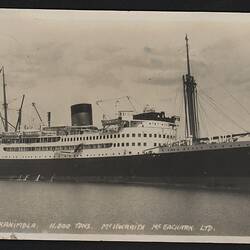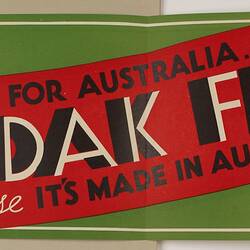Summary
Postcard sent in August 1939 from Cairns by Mr Edgar Rouse, Chief Managing Director of Kodak Australasia Pty Ltd, to Harry Clarke, the young son of two of his employees, who lived at the Kodak factory in Abbotsford, Melbourne. The postcard features a black and white image of the motor ship M.V. Kanimbla, and it is thought that Mr Edgar Rouse travelled from Melbourne to Cairns on this ship.
Newly appointed as the Chief Managing Director after the previous incumbent, his father Mr John 'JJ' Rouse, had died in 1938, Mr Edgar Rouse was visiting the USA to consult with Eastman Kodak executives at the head office in Rochester, New York. While away on his trip, Mr Rouse sent a number of postcards to thirteen year old Harry Clarke and his parents. Harry was the young son of two Kodak Australasia employees who lived onsite at the Kodak factory in Abbotsford, Melbourne. When he returned to Australia, Mr Rouse also gave a number of postcards and souvenirs to Harry Clarke.
Harry Clarke lived on the Kodak factory site in Abbotsford with his parents at the 'Yarra Grange' house from 1938, when he was twelve years old, until 1952, when he was twenty six years old. His mother was the chef in the Kodak directors' dining room and his father worked in silver recovery and then later was a gardener at Kodak. He felt very important to have the chief of Kodak interested in his well-being. Harry remembers that Mr Rouse 'took a shine to me as a small child and on one occasion invited me and his son, John Rouse to be guests with the directors of Kodak in their dining room, which of course brought great pride and joy to my mother. He wrote me cards and sent me cards of boats that he'd travelled on to America, and whilst he was in America he sent me very detailed postcards with long, handwritten notes... He was always very, very kind and gentle with, not only me but my mother and father, who he had great respect for.'
Harry says that 'When I lived at Kodak it was a huge, very huge place, and I seemed to live a very privileged life for a small child, I had the virtual run of the factory excepting some sections, particularly during the war years.... The staff at Kodak were like a large family. ...Living at Kodak at that time was very much like living in an enlarged family, everybody seemed to be very friendly and supportive, the dining room I think provided meals free of charge, there was a lot of benevolence in that period of time.'
The M.V. Kanimbla was an 11,000 ton ship that was built by Harland and Wolff in 1936 at Belfast in Ireland. The ship could carry about 400 passengers as well as cargo and livestock. It operated for the Scottish shipping firm, McIlraith McEacharn Limited, and did many years service in Australian waters transporting cargo and people on inter-state journeys. The Kanimbla was requisitioned shortly before World War II for naval duty, but was returned to civilian passenger transport after the war. The Kanimbla was sold in late 1960 and retired around 1972.
Physical Description
Postcard with black and white image of the ship the M.V. Kanimbla on the front, and a handwritten message on the back, with a stamp of King George VI and a Post Office postmark from Cairns, Queensland.
More Information
-
Collection Names
-
Collecting Areas
-
Acquisition Information
Donation from Harry Clarke, Oct 2009
-
Author
Mr Edgar J. Rouse - Kodak (Australasia) Pty. Ltd., Cairns, Queensland, Australia, 26 Aug 1939
-
Addressed To
Mr Harry T. Clarke Junior, Yarra Grange, Southampton Crescent, Abbotsford, Greater Melbourne, Victoria, Australia, 26 Aug 1939
-
Ship Depicted
MV Kanimbla (Motor Vessel), McIlraith McEacharn Limited, Cairns, Queensland, Australia, 26 Aug 1939
-
Inscriptions
Printed, ink, front, white: ' M.V. KANIMBLA / 11,000 TONS. / McILWRAITH / McEACHARN. LTD.' Printed, ink, back, black: POST CARD / CORRESPONDENCE / ADDRESS ONLY' Stamped, back, black ink, over postage stamp: 'CAIRNS / (indistinguishable date) / QLD.' Handwritten, ink, back left: ' Kind regards / to you and your / parents / Edgar Rouse / Cairns 26/8/39 ' Handwritten, ink, back right: ' Mr. H. Clarke Junr / Yarra Grange / Southampton Cres. / Abbotsford N9 / Victoria'
-
Classification
-
Category
-
Discipline
-
Type of item
-
Overall Dimensions
136 mm (Width), 87 mm (Height)
-
References
Pemberton, Barry, 'Australian Coastal Shipping', Melbourne University Press, Melbourne, 1979, pp.7, 114, 150, 230, 232, 245. Andrews, Graeme, 'A Log of Great Australian Ships', Reed, Sydney, 1980, p.73.
-
Keywords
Correspondence, Photography, Postcards, Recreation, Shipping Lines, Ships, Travel, Making History - Kodak Collection



